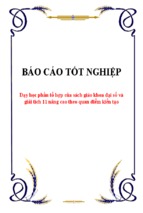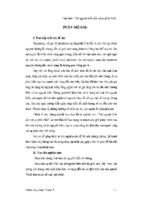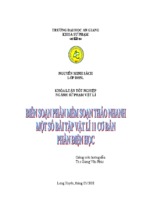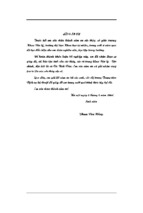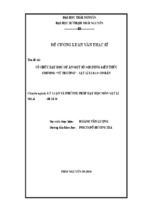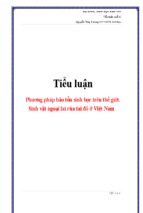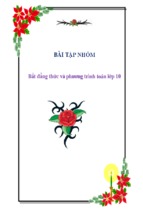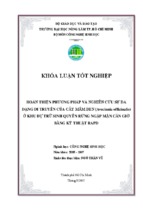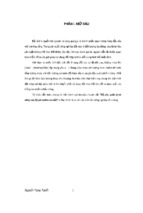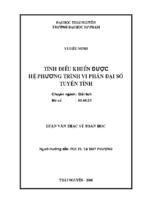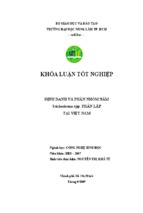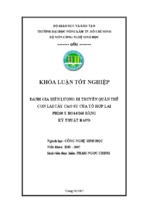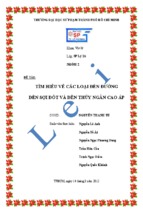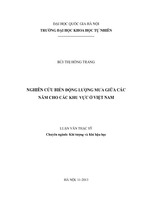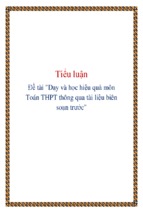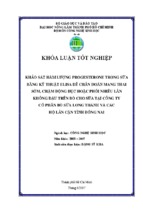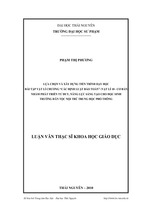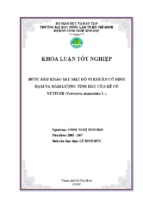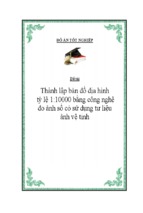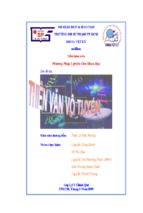Name: Nguyen Ngoc Sy
ID: 2448471
Class: MBAOUM0512-2C
1. EXECUTIVE SUMMARY
With the “Doi moi” policy, the Vietnamese socio-economic situation has been changed
fundamentally to move from a central planned economy to a market regulated one. Many
companies have been established to fulfill the higher social requirements day by day.
Besides the state-owned companies, a lot of private ones have been set up in all of the
sectors which Vietnamese government has allowed to. In the light industry, textile sector
has an important role not only for the satisfaction of basic needs but also the sense of job
solution due to its labor-intensified characteristic. Therefore, Vietnamese government has
provided many conditions to stimulate the establishment of textile companies, especially
the private ones that are estimated to have a lot of potential and opportunity to develop.
Thai Tuan Textile is a private company, established in December 1993, to produce
some kinds of textile product such as embroidery silk, satin, sateen etc. for female
customers. Although located in Ho Chi Minh City, its products are distributed throughout
Vietnam and exported to other countries for overseas Vietnamese people through the
intermediaries.
In recent years, Thai Tuan Textile emerges as a successful typical of private
Vietnamese company in the textile industry. The company has gained some achievements
in introducing diversified and high quality products, developing new markets. Its main
products are chosen as the first rank of textile products of Top Ten of Vietnamese high
quality products. Thus, there is a necessary need for studying its market success in terms
of technology strategies, which could help company exploit its competitive advantages to
cope with the other bigger competitors and be the successful leader in the textile market.
2. PROBLEM STATEMENT
Private sector has proved the effective and efficient contributions to the Vietnamese
economic development. It has showed its dynamic when giving new products and services
to satisfy the higher customer requirements day by day. There are numerous researches to
study its role and contributions to the economic development. However, very little has
been done to look into its competitive advantages because of technology transfer and
renovation.
In the textile industry, some researches just concern the needs of technology as the
prerequisite of existence in the fierce competition of globalization. Most of them consider
BUSINESS RESEARCH METHOD
Page 1/30
Name: Nguyen Ngoc Sy
ID: 2448471
Class: MBAOUM0512-2C
the state-owned companies. Therefore, it is necessary to study the role of technological
strategy in the private company, especially in the textile industry where the speed of
technology innovation is considered one of the highest sectors. This research can give
some experiments of implementing technological strategy to apply for the other private
textile companies.
3. RESEARCH OBJECTIVES
To analyze business position of Thai Tuan Textile Ltd. in the Textile Industry;
To analyze some major textile market factors affecting to its Business Strategies;
To analyze Technological Strategies of Thai Tuan Textile Ltd. in terms of relationship
to business strategies to exploit and create its competitive advantages in textile markets
by giving continuously new products to satisfy customer requirements;
To find some experiments of implementing technological strategies to apply for the
other textile companies;
To give Technology Strategy suggestions.
4. LITERATE REVIEW
4.1. Definition of Technology
The first step in understanding the Technology Strategy will start with a proper
definition of technology. The most comprehensive definition, however, has been
attributed to Sharif (1987) who considers technology as a combination of four basic
components, all of which together accomplish any transformation operation. These
components are:
Production tools and facilities, referred to as object-embodied technology or
technoware. This includes all physical facilities required for the transformation
operation such as instruments, equipment, machinery, devices, structures, etc.
Production skills and experiences referred to as person-embodied technology or
humanware. This embraces all acquired abilities necessary for the transformation
operation such as expertise, proficiencies, dexterity, creativity, diligence, and
ingenuity.
Production facts and information referred to as document-embodied technology or
inforware. This includes all accumulated facts and figures required for the
BUSINESS RESEARCH METHOD
Page 2/30
Name: Nguyen Ngoc Sy
ID: 2448471
Class: MBAOUM0512-2C
transformation activity such as designs, accounts, manuals, specifications,
observations, regulations, equations, charts, theories.
Production arrangements and linkages referred to as institution-embodied technology
or orgaware. This includes all necessary arrangements for the transformation
operation such as groupings, allocations, systematization, organizations, networks,
management, and marketing.
4.2. Factors Affecting to the Technological Strategies
4.2.1. Business Strategy
Managing technology is not only an operational issue, but also a major strategic issue.
Unless business strategy includes the impact of technology, a major portion of the
business is being ignored (Gerard H. Gaynor, 1991). Technological strategy should be
formulated within the larger context of business planning, since technology is the only one
component of the business system. As long as marketing strategy, technological strategy
concretizes the business goals to real actions.
Technological strategies must be properly integrated into overall business strategies of
an enterprise and followed the product/technology life cycle (Sharif, 1991)
Technology leader strategy through generation of state-of-the-art technologies.
Technology follower strategy through the adaptation of advanced technologies.
Technology exploiter strategy through the exploitation of standardized technologies
in a growing market.
Technology extender strategy through the extension of the salvage value of
obsolete technologies.
Within the current and future scope of the business, technological strategy is also a
cross functional integrated framework for consideration and assessment of technologies
available to the firm (Wilson, 1986)
Product development, the glamour side of technology on which most attention is
devoted.
Process development, the shadow side of technology, too often neglected or given
short shrift, and including manufacturing technology, material handling, packaging,
inventory control.
Information system and office automation.
BUSINESS RESEARCH METHOD
Page 3/30
Name: Nguyen Ngoc Sy
ID: 2448471
Class: MBAOUM0512-2C
When considering the relationship between technological strategy and business
strategy, Noori (1990) highlighted three important points:
Technological strategy must be developed collectively with manufacturing,
marketing, and other functional strategies because technology decisions can have major
impact on each of these areas, and vice versa.
Technological strategy must be formed in conjunction with the firm’s business
strategy because a right choice of technology provides key competencies.
Technological strategy must support any future revision of the firm’s business
strategy and its competitive advantage.
The basic role of technological strategy in business planning is to help ask the
questions of in what businesses the corporation plans to be and how positioned (Frederick
Bestz, 1987). It identifies the potential impact of technological change on any part of the
value chain (Porter, 1985).
4.2.2. Organizational Context
Organizational context has the important role to the selection of technological strategy.
It allows the firm to substitute internal selection for external selection. The effectiveness
of the firm’s internal selection environment affects its capacity to deal with major strategic
management challenges (Bulgelman, Mandique and Wheelwright, 1996):
The ability to exploit opportunities associated with the current strategy (induced
process).
The ability to take advantage of opportunities that emerge spontaneously outside
the scope of the current strategy (autonomous process).
The ability to balance these challenges at different times in the firm’s development.
Organizational context reflects the firm’s administrative approaches and dominant
culture. It is impacted by the background and management approaches of the firm’s
founders. This expresses in the selection of technological strategy: leader or follower and
technology innovation: insourcing or outsourcing. It also has a close relationship to
technology capabilities in terms of deciding technological strategy (Bulgelman, Mandique
and Wheelwright, 1996).
In the firm, organizational capabilities must accompany technological ones (Lall,
1987). These can be reflected through some or all of the following:
BUSINESS RESEARCH METHOD
Page 4/30
Name: Nguyen Ngoc Sy
ID: 2448471
Class: MBAOUM0512-2C
Separation of the different technological functions (into different units) in the
organizational structure with the growth of the firm.
Giving greater autonomy and financial control to technological functions (like
R&D), as these gain prominence, without letting them lose touch with day-to-day
commercial needs.
Facilitation of technological information transfers across different departments and
from the shop floor, and response to consumers’ feedback.
Development of technology-sensing services (technical library, patent data, data on
world technological trends, etc.).
Formal documentation (in manuals, technical papers, data banks, design libraries
and so on) of technical knowledge accumulated.
Link-up with technology suppliers, laboratories, industry associations, universities
and drawing on in-house training programs and external programs.
4.2.3. Technological Capability
Technological strategy can be conceptualized as an evolutionary organizational
learning process, which links between technical competencies and capabilities,
technological strategy, and experience. Technological strategy is a function of the quantity
and quality of technical capabilities that feed into it. The experience that results from
enacting technological strategy similarly feeds back into technical capabilities and
technological strategy, thus continuing the cycle as seen in figure 1:
Technological
Capabilities
Technological
Strategy
Experience
Figure 1: A capabilities-based organizational learning framework of technological
strategy.
Technological capability is the ability to use effectively technological knowledge. It is
the primary attribute of human knowledge and the know-how, which effectively combines
human skills and physical capital to meet human needs.
Some following elements to define technological capability had been suggested (Bell
and Hill, 1978):
Executing major and/or minor innovative activity.
BUSINESS RESEARCH METHOD
Page 5/30
Name: Nguyen Ngoc Sy
ID: 2448471
Class: MBAOUM0512-2C
Effecting necessary adjustments through the production system from the point of
introduction of innovation.
Deciding for technical change.
Effecting technical change
Optimizing operation.
The application of technological knowledge has been broken down by Dahlman and
Westphal (1982) into the following activities:
Production engineering that related to the operation of existing plants.
Project execution that pertains to the establishment of new production capacity.
Capital manufactured goods that consist of the embodiment of technological
knowledge in physical facilities and equipment.
Research and Development activities to generate new technological knowledge.
Technological capability can be defined as a combination of three kinds of independent
capabilities includes independent technology learning capability (ITLC), independent
technology creating capability (ITCC), and independent world technology reconnaissance
capability (IWTRC) (Dore, 1984).
On the other hand, Fransman (1984) identified the elements of technological capability
as follow:
Capability to search for and select appropriate, alternative technology.
Capability to master imported technology and successfully use it for the
transformation of inputs and outputs.
Capability to adapt technology to suit local conditions of production.
Capability to make incremental innovations resulted from further improvement in
adopted technology.
Capability to institutionalize search for breakthroughs and innovation through local
R&D facilities.
Capability to carry out basic research for furthers upgrading the technology.
The technological capability development efforts in India proved that technological
capability is shown by the ability for purchasing technology, the ability for plant
operation, the ability for duplication and expansion and the ability for innovation (Ashok
Desai, 1984).
BUSINESS RESEARCH METHOD
Page 6/30
Name: Nguyen Ngoc Sy
ID: 2448471
Class: MBAOUM0512-2C
Four types of technological capability were proposed by The Thailand Development
Research Institute (TDRI, 1989) based on the revision of World Bank study. They include
Acquisitive capability relates to the capability to search for, assess, negotiate,
procure, and transfer technology and installation/ start-up.
Operative capability integrates the abilities for operation and control, maintenance,
training and management.
Adaptive capability includes knowledge acquisition, technology digestion, minor
product and/or process modification.
Innovative capability embodies research and development capabilities, and radical
product and/or process modification
4.2.4. Government Policies
There is a wide range of government policies that affect the efforts of firms in any
industry to accumulate technological capabilities. As a result, they also influence the
technological strategy of the firm. These policies include trade policies (policies towards
import of technologies), investment incentives, fiscal and monetary policies, tariff
regulations, etc.
Government legislation can create a demand driven pressures of competition or even
foreclose entry into industrial sectors with controls by licensing arrangements, raw
materials and capital access. Government goes by to create direct social benefits but the
secondary consequences are a creation of entry barriers (Porter, 1985). Therefore, it can
make the transformation of industrial structure, which affects directly to the technological
strategies of firms in this industry.
Government can facilitate technological capability development of industrial firms
through providing:
Testing services to qualify products to meet local and international standards.
Information centers to provide information related to technology alternatives.
Institutions for education, training and R&D.
Besides, government policies for the certain industry can affect to the other related
industries due to the mutual relationship among industries in terms of providing input and
consuming output.
BUSINESS RESEARCH METHOD
Page 7/30
Name: Nguyen Ngoc Sy
ID: 2448471
Class: MBAOUM0512-2C
4.2.5. Technology Forecasting
Using technology as a competitive factor must begin with anticipating technological
change. Technology forecasting uses techniques for the business organization to
systematically anticipate relevant technological changes.
Technological changes influence the Technological Capabilities as well as
Technological Components. The general impact of technological changes is to make some
of the Technological Components obsolete and alter the relative importance of the
Technological Capabilities. These changes make the influences to the Product Market.
The dynamics of the Product Market due to technological changes are described by two
phenomena (Corbett and Wassenhove, 1993):
Qualifying Criteria becomes tougher: the minimum performance levels, which must
be met in order to prevent the loss of market share become higher. One must constantly
improve in absolute terms simply to prevent being wiped out of market.
Order Winning Criteria become Qualifying Criteria: what one time is considered by
customers to be a valuable extra feature can, as they become used to it and technological
changes, become a standard minimum requirement.
Forecasts are important inputs to the process of strategy formulation and planning.
They have been used to gain a better understanding of the threats and opportunities likely
to be faced by established products and markets and, consequently, of the nature and
magnitude of the changes needed (Bulgelman, Mandique and Wheelwright, 1996).
The usefulness of technology forecasting techniques is not only in the prediction, but
also in their value to business planning for systematically searching out potential and
relevant technical change. The next step after technology forecasting is formulating
technological strategy which is set up what will be done to use technology as the effective
and efficient to get the competitive advantage (Frederick Bestz, 1993).
4.2.6. Technology Content Addition
In rapidly changing environments, it is essential to sense the need to reconfigure the
asset structure and accomplish the necessary internal and external transformation. This
reconfiguration and transformation has to be done such that the Value Addition and the
process of Technology Content Addition are aligned to each other. The technology Atlas
Team (1987) defined the Technology Content Addition of a transformation activity in
BUSINESS RESEARCH METHOD
Page 8/30
Name: Nguyen Ngoc Sy
ID: 2448471
Class: MBAOUM0512-2C
terms of the four technology components, which are used in the transformation facility.
The four technology components are considered to be equivalent to the factors of
production used in the calculation of a production function.
4.3. Data collection
Data for this research includes primary and secondary and will be collected as follows:
4.3.1. Secondary Data
Annual Statistical reports on the social, economic aspects from The General
Department of Statistics to get general information on the macro environment.
Textile Industry’s Reports to get information on the industry’s structure.
Thai Tuan Textile Ltd. Annual report, and documents and Phuoc Long Documents.
Some magazines: such as Saigon Times Magazine, Saigon Marketing Magazine,
Science and Technology Magazine, Magazine of Ministry of Light Industry and others.
From the Internet.
4.3.2. Primary Data
In-depth interview and discussion with top manager of Thai Tuan Textile Co. Ltd.: Mr.
Thai Tuan Dung, Vice General Director of Permanent to obtain information related to
company strategies.
In-depth interview and discussion with experts of Thai Tuan Textile Co. Ltd.: Mr. Vo
Van Quyen, Director of Administration Department, Mr. Vo Van Sang, Vice General
Director of Technology-Production and Mrs. Vo Thi Quy, consultant to know clearly
production process and relevant technical and financial problems.
5. JUSTIFICATION
This study will focus on the way of implementing of Technological Strategy of Thai
Tuan Textile Ltd. to gain the competitive advantage and be the leader of Vietnamese
textile market in terms of textile products for female customers.
Because the technological strategy is rather a wide concept for not only Thai Tuan
Textile Co. Ltd. but Vietnamese companies generally, the managers just said what they
did relating to the strategy and production rather than giving systematic steps they had
taken to achieve and implement technology. Some information was not available due to
the business confidentiality.
BUSINESS RESEARCH METHOD
Page 9/30
Name: Nguyen Ngoc Sy
ID: 2448471
Class: MBAOUM0512-2C
6. RESEARCH DESIGN
The design for the research is presented as the following figure:
COMPANY’S MISSION
AND GOALS
INTERNAL
ANALYSIS
EXTERNAL
ANALYSIS
BUSINESS STRATEGY
TECHNOLOGICAL STRATEGY
FORMULATION PROCESS
TECHNOLOGICAL STRATEGY
IMPLEMENTATION PROCESS
EVALUATION
6.1. Company Background
6.1.1. Company History
Established on 20th December 1993, Thai Tuan Textile Co. Ltd. was initially a private
company acting mostly in the trading activities with its former name as Thai Tuan
Producing and Trading Co. Ltd. Besides the subcontracting of making sub-products of
fabrics, it still traded kinds of fabric and raw materials of textile industry such as threads
and kinds of chemical.
By the year 1995, the demand of fabric was high day by day and the domestic market
was overwhelmed with the foreign fabrics. Realizing that this was the opportunity and
there was enough capability, company carried out construction of departments,
importation of equipment, materials and recruiting staff to produce the fabrics which have
high quality as the import ones. In May 1996, the weaving factory was established and
produced officially in October 1996. In this period, the main company product was the
rough fabric, which was dyed by the other companies and consumed mainly in the HCM
City and Mekong Delta.
In January 1997, company went on doing the construction of dyeing factory to
complete their products, step by step in their production process and cut off transportation
cost. In November 1997, the dyeing factory began to start its business activities.
BUSINESS RESEARCH METHOD
Page 10/30
Name: Nguyen Ngoc Sy
ID: 2448471
Class: MBAOUM0512-2C
From 1997 to the present time, company has done its business following market
mechanism, using its own capital and amortizing money to modernize their production
process. To satisfy the demand of diversification of market, company decided to invest the
second weaving factory in March 1999. So far, company makes products and distributes
its products simultaneously through its whole national network distribution and two
showrooms in HCM City. This contributes to the increase of consuming fabrics in the last
two years
Table 1: The consuming fabric and growth rate of Thai Tuan Textile Co. Ltd.
Year
2010
2011
2012
Consuming fabric (million meter)
4.2
6.1
7.5
Turnover (billion VND)
100
180
200
-
45.24
23
Growth rate (%) compared with
the previous year
Source: Thai Tuan’s Documents.
In 2011, the turnover increased rapidly because the first company products such as
kinds of embroidery silk, satin etc. hit the market and prompted the replacement of
Vietnamese high quality fabrics for the foreign ones. Thai Tuan textile products begin to
be well known and appeared in the fashion shows.
6.1.2. Organizational Structure
The company management system is organized by the form of mixing mechanistic and
organic models. It assures the unique manager system to manage directly with the efficient
support of functional departments. The organizational structure of company consists:
Board of Management: this includes 4 founders to define the company strategic issues
and to solve the big problems.
General Director.
Vice General Directors: Permanent, Sales and Technology- Production.
Directors of functional departments and mills: Finance-Accounting, Administrative,
Sales, Marketing, Production and R&D, Spinning and Weaving, Dyeing and Finishing.
Duties of Vice General Directors, Directors of functional departments and each
department are described as below:
BUSINESS RESEARCH METHOD
Page 11/30
Name: Nguyen Ngoc Sy
ID: 2448471
Class: MBAOUM0512-2C
Vice General Directors and Directors of functional departments:
- Forming the regulations to manage the company.
- Appointing the qualified people to handle the important positions.
- Concentrating the company resources to orient the target strategies to achieve the
company objectives.
Production and R&D Department:
- Planning the production strategies and tactics through balancing between resources
and market demands.
- Researching and designing new models to satisfy timely market demands.
- Planning and managing production plans as well as giving solutions to use effectively
and efficiently machines and equipment.
- Regulating production through providing materials and receiving products distributed
to sales department.
- Managing production technology.
Administrative Department:
- Making plans and organizing the recruitment, staffing, forming and training human
resource.
- Solving all of the staff claims and accusations in the working time.
- Researching, planning, orienting and organizing the problems related to the labor cost
regulations, wage payment forms and income distributions.
- Representing company to establish relationship with public agencies, social
organizations.
- Managing documents and circulating information to assure the company activities.
Finance- Accounting Department:
- Recording and reflecting the economic activities completely, and timely.
- Defining business results, forecasting capital demands and balancing the budget to
assure the normal stage between the production activities and financial capability.
- Controlling the legal status of vouchers occurring in the management processes.
- Forming and selecting the appropriate mobilizing and lending forms when needed.
BUSINESS RESEARCH METHOD
Page 12/30
Name: Nguyen Ngoc Sy
ID: 2448471
Class: MBAOUM0512-2C
Sales and Marketing Departments:
- Distributing company products to customer.
- Catching the market information: products, prices, competitors; finding new
customers, new markets and discovering new demands.
- Collecting new styles and designs in the market.
6.2. Potential Development
Quality is the first priority of the company to set up the company brand position to the
consumer through the supply with the first Vietnamese high quality fabrics such as silk,
embroidered silk, satin. The next year is the goal of “fashion and quality” to affirm the
company ability in terms of providing to the customer with not only high product quality
but fashion ones.
With the investments and the customer- oriented approach, company has asserted
strongly the company position in the consumer choice for the high quality fashion fabrics
of Vietnamese dress and other fashion ones. Company imported the equipment to print the
brand name on their products in order to assure quality of company products and receive
the support of market as well as increasing the consumer trust for the Vietnamese
products. In addition, this helps to replace the import fabrics and save the foreign money
for country. In the trade fairs and exhibitions of new products, company products always
make the consumer concentration and lead forward the turnover compared with other
company products. Company has got the gold medal of quality product and diploma of
merit of People’s Committee of HCM City for the company, which has the efficient
production and business activities.
Nowadays, company is considered to be one of the most successful private companies
in HCM City and its kinds of embroidery silk have just received the first position of textile
products in the consumer selection of Vietnamese high product quality.
6.3. External Analysis
6.3.1. Threats
Due to implementing CEPT (Common Effective Preference Tariff) Scheme in 2006
because of the joint of AFTA, the competition between domestic textile products and
imported ones from China, Thailand and Indonesia has increased considerably.
BUSINESS RESEARCH METHOD
Page 13/30
Name: Nguyen Ngoc Sy
ID: 2448471
Class: MBAOUM0512-2C
The appearance and development of private companies as well as state-owned ones
producing the same Thai Tuan’s fabric products with some certain advantages have
made the increase of rivalry.
The competitive pressure comes from the imported and smuggled Chinese and South
Korea fabric products.
The fluctuation of materials price will affect greatly to product price due to the major
dependence of imported materials.
The changes of customer’s taste.
6.3.2. Opportunities
Textile domestic production does not meet the actual demand of market.
Government policies support the development of textile-garment industry in terms of
information, capital, tax and training courses, especially in technology renovation.
International markets of textile products are being increasingly enlarged.
There is a tendency of transferring textile technology from developed and NIC
countries to the countries, which have the low labor cost. Therefore, it is not difficult to
obtain and apply new technology.
The tendency of using Vietnamese high quality products and the recovery of wearing
Vietnamese traditional dress.
When deciding to shift from the major trading activities from manufacturing, company
faced the problems related to the market segmentation, product characteristics and
technology for production process.
The situation in for Thai Tuan Textile Co. Ltd. can be expressed in the table below.
Opportunities
High demand of embroidery silk and
satin by female customers.
The development of middle classes in
cities and even in rural areas.
So far, there was no Vietnamese
textile company producing
embroidery silk.
BUSINESS RESEARCH METHOD
Threats
The invasion of foreign fabric
products with the certain advantages
of color and pattern.
The increase pressure of competition
in textile market.
The higher customer requirements
for fabric products.
Page 14/30
Name: Nguyen Ngoc Sy
ID: 2448471
Class: MBAOUM0512-2C
6.4. Internal Analysis
6.4.1. Main Financial Figures and Market Share
6.4.1.1. Main Financial Figures
Table 2: Main Financial Figures of Thai Tuan Textile Co. Ltd.
Sources of Capital
(million VND)
Owned Capital
9,000
Long-term
31,449.083
Loans
Short-term
21,322.051
Loans
Capital Structure
(million VND)
Fixed Assets
31,112.851
Liquid Assets
29,935.518
Other Capitals
722.765
Figures
Unit
Billion VND
Turnover
Billion VND
Tax Payments
People
Labor
Average Wages VND/People/Month
Source: Thai Tuan’s Documents.
2010
100
16
960
3,700,000
2011
180
26.8
1020
3,900,000
2012
200
34.5
1415
4,100,000
It is noticed that the owned capital has a small proportion (14.6%) in the total
investment capital. This is the bankruptcy threat for company if it does business
inefficiently. However, thanks to their effective activities and high growth rate, company
has expended their company size as well as increased average wages though company has
paid the significant increase tax.
Capital Structure also shows the greatly concentrate investment of company for the
machinery (50.4%) to achieve the production capability which satisfies the descriptive
objectives related to product quality.
6.4.1.2. Market Share
The Market Share of each kind of fabric product of Thai Tuan Textile Co. Ltd. is
expressed in the table 3 below
Table 3: Market Share of each kind of Thai Tuan’s products
Kind of fabric product
Market Share (%)
Embroidery Silk
27
Sateen
10
Silk
8
Satin
4
Source: Thai Tuan’s Documents.
% of consumed output
52
38
7
3
Overall market share of Thai Tuan Textile Co. Ltd.
= (27x52 + 10x38 + 8x7 + 4x3)/ 100 = 18.52%
BUSINESS RESEARCH METHOD
Page 15/30
Name: Nguyen Ngoc Sy
ID: 2448471
Class: MBAOUM0512-2C
6.4.2. Products
When the living standard is raised, the consume tendency of Vietnamese people begin
to shift to use the high product quality. Thai Tuan Textile Co. Ltd. is known as the Textile
Company which provides the fashion fabrics to make the Vietnamese dress as well as the
fashion cloths for ladies.
At present, company produces some textile products:
Kinds of embroidery silk make up 52% of consumed output in which:
- Roughen embroidery silk makes up 39% of consumed output.
- Sleeked embroidery silk makes up 7% of consumed output.
- Grained embroidery silk makes up 3% of consumed output.
- Elasticized embroidery silk makes up 3% of consumed output.
Kinds of sateen (shiny sateen, grained sateen, smoothen sateen) makes up 38% of
consumed output.
Silk makes up 7% of consumed output.
Satin makes up 3% of consumed output.
Silk
7%
Satin
3%
Sateen
38%
Embroidery
Silk
52%
Figure 2: Structure of ThaiTuan Textile Products
Source: Thai Tuan’s Documents.
Today, Thai Tuan textile products have been consumed all over the country in which
HCM City and the Mekong Delta considered the biggest markets. They also have been
exported to U.S, France, Canada, Germany and many other countries through the
intermediaries.
BUSINESS RESEARCH METHOD
Page 16/30
Name: Nguyen Ngoc Sy
ID: 2448471
Class: MBAOUM0512-2C
6.4.3. Production Process
The company process technology to produce fabrics is a closed process, which
contains five main sub-processes (fig. 3). They are (1) spinning, (2) weaving, (3) dyeing
and finishing, (4) classifying and (5) packaging. Each of them, however, includes several
other steps to eventually produce their respective final products, that is, warp and filling
yarns in the spinning process; gray cloth in weaving; dyed cloth in dyeing and finishing;
up-to-standard fabric in the classifying and fabric roll in the packaging process.
6.4.4. Current Technology
Current Technology in the Thai Tuan Textile Co. Ltd. is considered in terms of four
technological components: technoware, humanware, inforware and orgaware.
6.4.4.1. Technoware
Textile technology is generally considered based on the generations of machinery and
equipment, which is an essential competitive advantage for a textile company. The quality
of fabric as well as production cost depends so much on the generations of machinery
used.
There are two main spinning systems used in the world: ring spinning and open-end
rotor spinning. Ring spinning is much less productive than rotor spinning system. Ringspinning system is used in Thai Tuan Textile Co. Ltd. Although being ring spinning
system, all of spinning machinery are the brand-new ones with manufacturing year is
1995. They assure to provide the necessary quantity of yarns to the weaving looms. In the
other hand, fibers used are synthetic ones, which are standardized. Along with new
machinery, this makes the high quality warp yarns and filling yarns produced in the
spinning process.
In Vietnam, there are two main types of weaving technology. Traditionally, looms with
shuttles are used. This technology has slow production rate and requires higher skills of
technicians and weavers. Most of Vietnamese textile companies are using shuttle looms in
their factories. The second type is the weaving technology with shuttleless looms. They
allow broadening the width of fabric produced. They can produce high standard fabrics
and the rate of substandard product is low.
In addition, the high quality of company products are achieved and maintained through
the computerized dyeing equipment, which few of textile companies have at this time.
BUSINESS RESEARCH METHOD
Page 17/30
Name: Nguyen Ngoc Sy
ID: 2448471
Class: MBAOUM0512-2C
6.4.4.2. Humanware
“Our people are our greatest resource” is one of the statements most commonly found
in reports of many companies. Without the right people in the right positions, no strategy,
however, well formulated in other respects, is likely to succeed. The objective of strategic
human resource management is to develop manpower plan that matches people with a
company’s strategic requirements, both in the short run and the long run. Realizing this
importance, from the establishment to the present time, human resource management is
always the concentration of setting company strategies in Thai Tuan Textile Co. Ltd.
Related to the human resource, the number of company staff is 1415, which contain
181 managers (12.8 %), and 1234 workers (87.2 %).
Before being accepted to the company, all of workers must pass the skill examination
to make sure they can use effectively machinery and equipment in the production process.
The recruitment is done by the Administrative Department based on the company
development and expansion plans of production process. All of them come from the
family, which has the tradition of working in textile industry or shift from the other textile
companies.
For the managers, all of them have the engineer/ bachelor degrees (for officers) or high
skill and experience degrees (for foremen). For directors, beside the educational degree,
they also have working experiences and good relationship with textile industry and
government agencies thanks to the long-term working process in the other textile
companies. All of company consultants have master degree and come from well-known
institutes such as Asian Institute of Technology and Polytechnic Institute.
6.4.4.3. Inforware
Company has promulgated documents of company working regulation in which
stipulates the roles and responsibilities of each department and factory. Because most of
machinery is the new ones, company has sufficient documents in terms of specifications,
operation and maintenance manuals so that they can plan the maintenance plans to
maximize the machine performance. The machine maintenance is done regularly by the
technical groups. This helps company producing continuously without serious problems.
Every three years, all of machinery are overhauled and replaced defective components.
BUSINESS RESEARCH METHOD
Page 18/30
Name: Nguyen Ngoc Sy
ID: 2448471
Class: MBAOUM0512-2C
However, these documents (specifications and maintenance manuals) have been yet
disseminated widely to workers who just know how to operate machines and equipment
and overcome some small common problems appearing in the production process. This
limits the employee’s operative capability and huddles their supportive capability.
Employees cannot take full advantage of machinery they use as well as create
improvements when they do not know clearly their specifications. This is being overcome
thanks to the implementation of Total Quality Management (TQM) process to get the ISO
9000 Certificate in the company.
To select alternative technologies and choosing the appropriate ones, company has a
database, which is build from the different data sources. There are two kinds of them:
Primary sources include information coming from trade fairs of textile industry,
which is often organized annually. Although company cannot take part regularly
due to the capital limitation, they may get this information from the Vietnamese
commercial representatives in the opening country. Another source comes from the
database of National Science and Technology Information Center that stores almost
patents and inventions of all of industries all over the world.
Secondary sources are formed through the textile magazines, technical information
of newspapers, reports of consumer surveys etc. It must be concerned the important
role of information coming from the relatives, friends as well as competitors. Most
of the cases, this information is similar as orientation of searching information
process.
6.4.4.4. Orgaware
Company has the empower policy which allows directors decide all the problems
related to their responsible area. Thai Tuan Textile Co. Ltd. has a good staffing policy.
Recruiting managers based on the require experiences and skills is done through
interviewing carefully from 1 to 3 times depend on the importance of recruit positions.
Furthermore, the company set up a good relationship with universities and vocational
institutes in HCM City. Therefore, it has opportunities to attract graduates to work for the
company. Generally, company has put right person on right position to exploit the abilities
of each person.
BUSINESS RESEARCH METHOD
Page 19/30
Name: Nguyen Ngoc Sy
ID: 2448471
Class: MBAOUM0512-2C
6.5. Strategy Formulation Process
6.5.1. Forecasting Market and Technology
Based on the analyses of customers and textile products as well as technology
information which company has, company forecasts the tendencies of market and
technology in the future.
6.5.1.1. Market
Fabric product market will become more diversified with the anticipation of many
kinds from foreign and domestic textile companies. Because of increasing income, urban
customer tendency will shift from price concentration to value-orientation. Fabric products
made of natural materials and getting high requirements of pattern, color and surface
characteristics will be liked. In addition, the development of fashion clothes along with
their high requirements of coordinating pattern and color will make the use of wider width
size fabric products.
6.5.1.2. Technology
Today's yarn and fabric production speeds are many times what they were only a few
years ago. And quality levels have reached the point that some manufacturers find it is in
some cases an unnecessary expense to even inspect finished fabrics. The development of
synthetic fibers led to the production of new types of durable and easily cared-for fabrics.
In Vietnam, some of textile mills are beginning to use shuttleless looms due to the
notice of advantages related to high productivity and less noise making. Meanwhile, the
popular use shuttleless looms in many modern textile companies leads to the increase of
quantity of fabrics made of the shuttleless looms in the world.
Computer-based systems for optimizing dyeing time-temperature and improved color
matching are common results of these years of technology development since they were
developed in the early 1970’s. By monitoring and regulating the temperature and dye-bath
strength, for example, they are able to improve the color consistency of different pieces of
cloth. More recent advances in color physics combined with microelectronics have led to
the use of computer-based spectrophotometer, which can define shades numerically,
allowing colors to be repeated accurately, and also scan a piece of cloth for color
consistency. They are being used primarily by manufacturers supplying high-quality
fashions, for whom any color mismatching can lead to large financial losses.
BUSINESS RESEARCH METHOD
Page 20/30
- Xem thêm -


